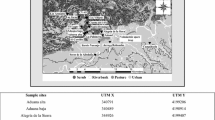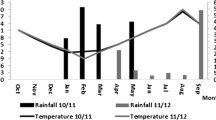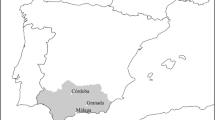Abstract
The present study sampled pollen grains in the atmosphere using a Burkard® 7-day-recording trap and periodically checked the flowering phases of Plantago lanceolata L. in the locality of León (NW of Spain) from late March to early August during 2007 and 2008. The results showed that the phenological phases considered for P. lanceolata coincided in most sampling points. The differences between them depended mainly on the characteristics of the land on which the plants developed and water availability. In addition, the differences between the start and duration of the different phenological phases over the 2 years were mainly due to climatic variations each year. Plantago pollen concentration in the atmosphere and phenological data were related during these 2 years of study. The differences in Plantago pollen production per anther were determined by environmental conditions such as humidity. Another important factor was human action.





Similar content being viewed by others
References
Aguilera, F., & Ruíz-Valenzuela, L. (2009). Study of the floral phenology of Olea europea L., in Jaén province (SE Spain) and its relation with pollen emission. Aerobiologia, 25(4), 217–225.
Alcázar, P., Stach, A., Nowak, M., & Galán, C. (2009). Comparison of airborne herb pollen types in Córdoba (Southwestern Spain) and Poznan (Western Poland). Aerobiologia, 25, 55–63.
Alexander, M. P. (1969). Differential staining of aborted and non aborted pollen. Stain Technology, 44(3), 117–122.
Andres, M. V., Rodríguez, J., & Duran, J. M. (1999). Viabilidad del polen de albaricoquero (Prunus americana L.). Investigación agraria. Producción y protección vegetales, 14(1–2), 25–32.
Barbieri, R., Rotarelli, L., Salis, A., & Zinoni, F. (1989). Guida alle rilevazioni agrofenologiche ed alla compilazione delle schede di relevamento per le colture erbacee el arboree. Bologna: ERSA.
Bassett, I. J., & Crompton, C. W. (1968). Pollen morphology and chromosome numbers of the family Plantaginaceae in North America. Canadian Journal of Botany, 46, 349.
Calabozo, B., Barber, D., & Polo, F. (2002). Reactividad cruzada entre los pólenes de Plantago lanceolata y Olea europaea. Alergologia e Inmunologia Clinica, 18(3), 125–126.
Calabozo, B., Díaz-Perales, A., Salcedo, G., Barber, D., & Polo, F. (2003). Cloning and expression of biologically active Plantago lanceolata pollen allergen Pla l 1 in the yeast Pichia pastoris. Biochemical Journal, 372, 889–896.
Cenci, C. A., & Ceschia, M. (2000). Forecasting of the flowering time for wild species observed at Guidonia, central Italy. International Journal of Biometeorology, 44, 88–96.
Chen, I. C., Hill, J. K., Ohlemüller, R., Roy, D. B., & Thomas, C. D. (2011). Rapid range shifts of species associated with high levels of climate warming. Nature, 333, 1024–1026.
Dąbrowska, A., & Kaszewsk, B. M. (2012). The relationship between flowering phenology and pollen season of Alnus Miller. Acta Agrobotánica, 65(2), 57–66.
D’Amato, G., & Lobefalo, G. (1989). Allergenic pollens in the southern Mediterranean area. Journal of Allergy and Clinical Immunology, 83, 116–122.
D’Amato, G., Spieksma, F. T. M., & Bonini, S. (1991). Allergenic pollen and pollinosis in Europe. Oxford: Blackwell Scientific Publications.
Darrow, K., & Bowers, D. (1997). Phenological and population variation in iridoid glycosides of Plantago lanceolata (Plantaginaceae). Biochemical Systematics and Ecology, 25(1), 1–11.
Delph, L. F., Johannson, M. H., & Stephenson, A. G. (1997). How environmental factors affect pollen performance: ecological and evolutionary perspectives. Ecology, 78, 1632–1639.
Dittmar, C., & Elling, W. (2006). Phenological phases of common beech (Fagus Sylvatica L.) and their dependence on region and altitude in Southern Germany. European Journal of Forest Research, 125, 181–188.
Estrella, N., Menzel, A., Krämer, U., & Behrendt, H. (2006). Integration of flowering dates in phenology and pollen counts in aerobiology: analysis of their spatial and temporal coherence in Germany (1992–1999). International Journal of Biometeorology, 51, 49–59.
Faegri, K., & Van Der Pijl, L. (1979). The principles of pollination ecology. Oxford: Pergamon Press.
Fitter, A. H., & Fitter, R. S. R. (2002). Rapid change in flowering time in British plants. Science, 296, 1689–1691.
Fornaciari, M., Galán, C., Mediavilla, A., Domínguez, E., & Romano, B. (2000). Aeropalynological and phenological study in two different Mediterranean olive areas: Córdoba (Spain) and Perugia (Italy). Plant Biosystems, 134(2), 199–204.
Galán Soldevilla, C., Cariñanos González, C., Alcázar Teno, P., & Domínguez Vilches, E. (2007). Spanish aerobiology network: Management and quality manual. Spain: University of Córdoba.
García-González, M. E. (1998). Efectos de las repoblaciones con pinos en la climax de la Querceta ilicis Mediterránea leonesa. Diputación provincial de León: León.
García-González, J. J., Vega-Chicote, J. M., Rico, P., Moscoso del Prado, J. M., Carmona, M. J., Miranda, A., et al. (1998). Prevalence of atopy in students from Málaga, Spain. Annals of Allergy, Asthma & Immunology, 180, 237–244.
García-Mozo, H., Galán, C., & Vázquez, L. (2006). The reliability of geostatistic interpolation in olive field floral phenology. Aerobiologia, 22, 97–108.
García-Mozo, H., Mestre, A., & Galán, C. (2010). Phenological trends in southern areas: A response to climate change. Agricultural and Forest Metodology, 150, 575–590.
González-Parrado, Z., Fernández-González, D., Camazón, B., Valencia-Barrera, R. M., Vega-Maray, A. M., Asturias, J. A., et al. (2014a). Molecular aerobiology: Plantago allergen Pla l 1 in the atmosphere. Annals of Agricultural and Environmental Medicine: AAEM, 21(2), 282–289.
González-Parrado, Z., Valencia-Barrera, R. M., Vega-Maray, A. M., Fuertes-Rodríguez, C. R., & Fernández-González, D. (2014b). The weak effects of climatic change on Plantago pollen concentration: 17 years of monitoring in Northwestern Spain. International Journal of Biometeorology, 58(7), 1641–1650.
Guardia, R., & Belmonte, J. (2004). Phenology and pollen production of Parietaria judaica L. in Catalonia (NE Spain). Grana, 43, 57–64.
Gutiérrez Bustillo, M., Cervigón, P., & Pertiñez, C. (2002). Aerobiología en Madrid. Estación de Ciudad Universitaria (2000–2001). REA, 7, 225–230.
Huertas, A. J., Mozota, J. M., & García-Cervantes, A. M. (2003). Relación entre la sensibilización a pólenes de palmera, Salsola y Plantago. Alergologia e Inmunologia Clinica, 18(3), 122.
Hyde, H. A., & Williams, D. A. (1945). Studies in atmospheric pollen. III. Pollen production and pollen incidence in ribwort pollen (P. lanceolata). New Phytologist, 45, 271–277.
Issarakraisilia, M., & Considine, J. A. (1994). Effects of temperature on pollen viability in Mango cv. ‘Kensington’. Annals of Botany, 73, 231–240.
Jato, V., Méndez, J., Rodríguez-Rajo, F. J., & Seijo, C. (2002). The relationship between the flowering phenophase and airborne pollen of Betula in Galicia (N.W. Spain). Aerobiologia, 18, 55–64.
Kang, S., Running, S. W., Lim, J. H., Zhao, M., Park, C. H.-R., & Loehman, R. (2003). A regional phenology model for detecting onset of greenness in temperate mixed forest, Korea: an application of MODIS leaf area index. Remote Sensing of Environment, 86, 232–242.
Käpyla, M. (1991). Testing the age and viability of airborne pollen. Grana, 29, 430–433.
Khanduri, V. P., & Sharma, C. M. (2002). Pollen production, microsporangium dehiscence and pollen flow in Himalayan cedar (Cedrus deodara Roxb. ex D. Don). Annals of Botany, 89, 587–593.
Khatun, S., & Flowers, T. J. (1995). The estimation of pollen viability in rice. Journal of Experimental Botany, 46, 151–154.
Koti, S., Reddy, R., Reddy, V. R., Kakani, V. G., & Zhao, D. (2005). Interactive effects of carbon dioxide, temperature and ultraviolet-B radiation on soybean (Glycine max L.) flower and pollen morphology, pollen production, germination and tube lengths. Journal of Experimental Botany, 56(412), 725–736.
Krilis, S., Baldo, B. A., & Basten, A. (1985). Detailed analysis of allergen specific IgE responses in 341 allergic patients. Associations between allergens and between allergen groups and clinical diagnoses. Australian and New Zealand Journal of Medicine, 15, 421–426.
Lacey, E. P., & Herr, D. (2005). Phenotypic plasticity, parental effects, and parental care in plants? I. An examination of spike reflectance in Plantago lanceolata (Plantaginaceae). American Journal of Botany, 92(6), 920–930.
Latorre, M. J., & Bianchi, M. M. (1998). Relationship between flowering development of Ulmus pumila and Fraxinus excelsior and their airborne pollen. Grana, 37, 233–238.
Lau, T. C., Lu, X., Koide, R. T., & Stephenson, A. G. (1995). Effects of soil fertility and mycorrhizal infection on pollen grain size of Cucurbita pepo (Cucurbitaceae). Plant, Cell and Environment, 18, 169–177.
León-Ruiz, E., Alcázar, P., Domínguez-Vilches, E., & Galán, C. (2011). Study of Poaceae phenology in a Mediterranean climate. Which species contribute most to airborne pollen counts? Aerobiologia, 27, 37–50.
Mahmoud, A. A., Bacha, A. M. A., & Farahat, A. (1998). Pollen viability, germination and rates of pollen tube growth in some pomegranate cultivars (Punica granatum L.). Journal of King Saud University Agricultural Sciences 10(1), 73–81.
Menzel, A. (2000). Trends in phonological phases in Europe between 1951 and 1996. International Journal of Biometeorology, 44, 76–81.
Murat Asma, B. (2008). Determination of pollen viability germination ratios and morphology of eight apricot genotypes. African Journal of Biotechnology, 7(23), 4269–4273.
Newham, R. M., Fountain, D. W., Cornford, C. C., & Forde, M. B. (1995). A national survey of airborne pollen and grass flowering in New Zeland, with implications for respiratory disorder. Aerobiologia, 11, 239–252.
Norton, J. D. (1966). Testing of plum pollen viability with tetrazolium salts. Proceedings of the American Society for Horticultural Science, 89, 132–134.
Orlandi, F., Ruga, L., Bonofiglio, T., Romano, B., & Fornaciari, M. (2014). Fifteen-year Phenological plant species and meteorological trends in central Italy. International Journal of Biometeorology, 58, 661–667.
Orlandi, F., Ruga, L., Romano, B., & Fornaciari, M. (2005). An integrated use of aerobiological and phenological data to analyse flowering in olive groves. Grana, 44, 51–56.
Osborne, C. P., Chuine, I., Viner, D., & Woodward, F. I. (2000). Olive phenology as a sensitive indicator of future climatic warming in the Mediterranean. Plant, Cell and Environment, 23, 701–710.
Oteros, J., García-Mozo, H., Vázquez, L., Mestre, A., Domínguez-Vilches, E., & Galán, C. (2013). Modelling olive phenological response to weather and topography. Agriculture, Ecosystems & Environment, 179, 62–66.
Parfitt, D. E., & Ganeshan, S. (1989). Comparison of procedures for estimating viability of Prunus pollen. HortScience, 24, 354–356.
Peñuelas, J., Rutishouser, T., & Filella, I. (2009). Phenology feedbacks on climate change. Science, 324, 887–888.
Prieto Baena, J. C., Hidalgo, P. J., Galán, C., & Domínguez, E. (2003). Pollen production in the Poaceae family. Grana, 42, 153–160.
Primack, R. C. (1978). Evolutionary aspects of wind pollination in the genus Plantago (Plantaginaceae). New Phytologist, 81, 449–458.
Puppi Branzi, G., & Zanotti, A. L. (1992). Estimate and mapping of airborne pollen sources. Aerobiologia, 8, 69–74.
Quirce-Gancedo, S. (2005). Asma. In Sociedad Española de Alergología e inmunología Clínica (SEAIC) y Schering-Plough (Eds.). Alergológica 2005. Factores epidemiológicos, clínicos y socioeconómicos de las enfermedades alérgicas en España (pp. 133–160). Madrid: Egraf, S.A.
Reale, L., Sgromo, C., Bonofiglio, T., Orlandi, F., Fornaciari, M., Ferranti, F., & Romano, B. (2006). Reproductive biology of olive (Olea europea L.) DOP Umbria cultivars. Sexual Plant Reproduction, 19, 151–161.
Rizzi Longo, L., & Pizzulin Sauli, M. (2010). Flowering phenology and airborne pollen occurrence of Corylus and Castanea in Trieste (Italy), 1991–2004. Acta Botanica Croatica, 69(2), 199–214.
Rodríguez-Riaño, T., & Dafni, A. (2000). Anew procedure to asses pollen viability. Sexual Plant Reproduction, 12, 241–244.
Roger Ickovic, M., Boussioud-Corbieres, F., Sutra, J. P., & Thibaudon, M. (1989). Hay fever symptoms compared to atmospheric pollen counts and floral phenology within Paris suburban area in 1987 and 1988. Aerobiologia, 5, 30–36.
Root, T. L., MacMynowsky, D. P., Mastrandrea, M. D., & Schneider, S. H. (2005). Human-modified temperatures induce species changes: joint attribution. Proceedings of the National Academy of Sciences of the United States of America, 102, 7465–7469.
Rutishauser, T., Luterbacher, J., Defila, C., Frank, D., & Vanner, H. (2008). Swiss spring plant phenology 2007: Extremes, a multi-century perspective, and changes in temperature sensitivity. Geophysical Reseach Letters. doi:10.1029/2007GL032545.
Sánchez-Mesa, J. A., Galán, C., & Hervás, C. (2005). The use of discriminant analysis and neural network to forecast the severity of the Poaceae pollen season in a region with a typical Mediterranean climate. International Journal of Biometeorology, 42, 355–362.
Satake, A., Kawagoe, T., Saburi, Y., Chiba, Y., Sakurai, G., & Kudoh, H. (2013). Forecasting flowering phenology under climate warming by modelling the regulatory dynamics of flowering-time genes. Nature Communications,. doi:10.1038/ncomms3303.
Schwartz, M. D. (1999). Advancing to full bloom: planning phonological research for the 21st century. International Journal of Biometeorology, 42, 113–118.
Sedgley, M., & Harbard, J. (1993). Pollen storage and breeding system in relation to controlled pollination of four species of Acacia (Leguminosae, Mimosoideae). Australian Journal of Botany, 41, 601–609.
Spano, D., Cesaraccio, C., Duce, P., & Snyder, R. (1999). Phenological stages of natural species and their use as climate indicators. International Journal of Biometeorology, 42, 123–133.
SIEMCALSA (1997). Mapa geológico y minero de Castilla y León. Junta de Castilla y León. Consejería de Cultura y Turismo, Valladolid (España).
Stennett, P. J., & Beggs, P. J. (2004). Pollen in the atmosphere of Sydney, Australia, and relationships with meteorological parameters. Grana, 43, 209–216.
Subba Reddi, C., & Reddi, N. S. (1986). Pollen production in some anemophilous angiosperm in air. Grana, 24, 109–113.
Subiza, J., Jerez, M., Jiménez, J. A., Narganes, M. J., Cabrera, M., Valera, S., & Subiza, E. (1995). Clinical aspects of allergic disease. Allergenic pollen and pollinosis in Madrid. The Journal of Allergy and Clinical Immunology, 96, 15–23.
Tackeray, S. J., Sparks, T. H., Frederiksen, M., Burthes, S., Bacon, P. J., Bell, J. R., et al. (2010). Trophic level asynchrony in rates of phenological change for marine, freshwater and terrestrial environments. Global Change Biology, 16, 3304–3313.
Tangmitcharoen, S., & Owens, J. N. (1997). Pollen viability and pollen-tube growth following controlled pollination and their relation to low production in teak (Tectonia grandis Linn. F.). Annals of Botany, 80, 401–410.
Tormo Molina, R., Silva Palacios, I., Muñoz Rodríguez, A. F., Tavira Muñoz, J., & Moreno Corchero, A. (2001). Environmental factors affecting airborne pollen concentration in anemophilous species of Plantago. Annals of Botany, 87, 1–8.
Tormo, R., Silva, I., Gonzalo, A., Moreno, A., Pérez, R., & Fernández, S. (2011). Phenological records as a complement to aerobiological data. International Journal of Biometeorology, 55, 51–65.
Trigo, M. M., Recio, M., Toro, F. J., & Cabezudo, B. (1997). Incidencia del polen de “Plantago” en la atmósfera de Málaga y su relación con los parámetros meteorológicos. Acta Botánica Malacitana, 22, 103–113.
Van Damme, J. M. M. (1992). Breeding systems in Plantago. In P. J. C. Kuiper & Bos, M. (Eds.), Plantago: A multidisciplinary study (pp. 12–18). New York: Springer.
Van Hinsberg, A. (1998). Maternal and ambient environmental effects of light on germination in Plantago lanceolata: correlated responses to selection on leaf length. Functional Ecology, 12, 825–833.
Van Tienderen, P. H., & Van Hinsberg, A. (1996). Phenotypic plasticity in growth habit in Plantago lanceolata: how tight is a suite of correlated characters? Plant Species Biology, 11, 87–96.
Wielgolaski, F. E. (2001). Phenological modifications in plants by various edaphic factors. International Journal of Biometeorology, 42, 158–168.
Wolff, K., & Van Delden, W. (1987). Genetic analysis of ecological relevant morphological variability in Plantago lanceolata L. I. Population characteristics. Heredity, 58, 183–192.
Zanotti, A. L., & Puppi, G. (2000). Phenological surveys of allergenic species in the neighborhood of Bologna (Italy). Aerobiologia, 16, 199–206.
Zerboni, R., Arrigoni, P. V., Manfredi, M., Rizzotto, M., Paoletti, L., & Ricceri, C. (1991). Geobotanical and phenological monitoring of allergenic pollen grains in the Florence area. Grana, 30, 357–363.
Acknowledgments
The authors are grateful to Anne Collins for editing the English text and M. Eva Vallejo Pascual for helping with statistical analysis. This study was supported by Grant CGL2006-15103-C04-03, Department of Science and Technology and Grant LE044A07, Junta de Castilla y León, Spain.
Author information
Authors and Affiliations
Corresponding author
Rights and permissions
About this article
Cite this article
González-Parrado, Z., Fernández-González, D., Vega-Maray, A.M. et al. Relationship between flowering phenology, pollen production and atmospheric pollen concentration of Plantago lanceolata (L.). Aerobiologia 31, 481–498 (2015). https://doi.org/10.1007/s10453-015-9377-3
Received:
Accepted:
Published:
Issue Date:
DOI: https://doi.org/10.1007/s10453-015-9377-3




